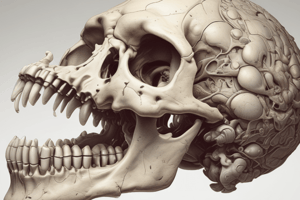Podcast
Questions and Answers
What is the difference between intramembranous ossification and endochondral ossification?
What is the difference between intramembranous ossification and endochondral ossification?
Intramembranous ossification forms the flat bones of the skull, face, jaw, and center of clavicle, while endochondral ossification forms most bones in the body, mostly long bones, replacing cartilage with bone.
What are the four types of bone fractures?
What are the four types of bone fractures?
- Comminuted fracture (correct)
- Closed fracture (correct)
- Greenstick fracture (correct)
- Open fracture (correct)
What are the functions of the muscular system?
What are the functions of the muscular system?
Skeletal muscles create movement and protect organs, cardiac muscles pump blood, and smooth muscles aid digestion and ensure blood flow.
What are the functions of the skeletal system?
What are the functions of the skeletal system?
What is the disorder known as Rickets/Osteomalacia?
What is the disorder known as Rickets/Osteomalacia?
What is the disorder known as Scoliosis?
What is the disorder known as Scoliosis?
What is the disorder known as lordosis?
What is the disorder known as lordosis?
What is the disorder known as kyphosis?
What is the disorder known as kyphosis?
What is a muscle spasm?
What is a muscle spasm?
What is a tremor?
What is a tremor?
What is a fibrillation?
What is a fibrillation?
What is a cramp?
What is a cramp?
What are the different shapes of bone?
What are the different shapes of bone?
What are the two divisions of the skeletal system?
What are the two divisions of the skeletal system?
What is the difference between the male and female pelvis?
What is the difference between the male and female pelvis?
What are the three structural classifications of joints?
What are the three structural classifications of joints?
What are the three functional classifications of joints?
What are the three functional classifications of joints?
What are the specific joints of the human body?
What are the specific joints of the human body?
What are the three ways to make ATP?
What are the three ways to make ATP?
Flashcards are hidden until you start studying
Study Notes
Ossification Processes
- Intramembranous Ossification: Forms flat bones (skull, face, jaw, clavicle) through sheet-like layers resembling membranes.
- Endochondral Ossification: Responsible for forming most bones, particularly long bones, by replacing cartilage with bone tissue.
Types of Bone Fractures
- Closed Fracture: Bone is fractured, but the skin remains intact.
- Open Fracture: Both bone and skin are damaged.
- Comminuted Fracture: Bone is splintered into multiple pieces.
- Greenstick Fracture: Partial fracture, common in children due to incomplete ossification.
Functions of the Muscular System
- Skeletal Muscles: Facilitate movement and protect internal organs.
- Cardiac Muscles: Pump blood throughout the body.
- Smooth Muscles: Aid in digestion and maintain blood flow.
Functions of the Skeletal System
- Support: Acts as a framework for the body.
- Protection: Safeguards internal organs from injury.
- Movement Assistance: Provides attachment points for skeletal muscles.
- Mineral Homeostasis: Stores and releases minerals like calcium and phosphorus.
- Blood Cell Production: Generates red/white blood cells and platelets.
- Triglyceride Storage: Yellow bone marrow stores adipocytes.
Disorders Related to Bones and Muscles
- Rickets/Osteomalacia: Caused by vitamin D deficiency, leading to inadequate calcification, resulting in rubbery bones in children and pain/fractures in adults.
- Scoliosis: Lateral bending of the spine, most common spinal deformity.
- Lordosis: Enhanced lumbar curve, often referred to as "hollow back."
- Kyphosis: Increased thoracic curve, commonly called "hunch back."
- Spasm: Sudden contraction of one muscle within a group.
- Tremor: Rhythmic involuntary contraction of muscles.
- Fibrillation: Spontaneous contraction of a single muscle fiber, detectable by electromyography, indicating potential motor neuron damage.
- Cramp: Painful muscle contraction due to inadequate blood flow, overuse, or dehydration.
Bone Shapes
- Long Bones: Longer than they are wide; examples include arms and legs.
- Short Bones: Cube-shaped; equal lengths and widths, found in the wrists and ankles.
- Flat Bones: Thin and flat; includes the skull, breastbone, and ribs.
- Irregular Bones: Complex shapes; includes hip bones and vertebrae.
- Sesamoid Bones: Small, seed-shaped bones; primarily the knee caps.
Divisions of the Skeletal System
- Axial Skeleton: Comprises the skull, hyoid bone, ear bones, vertebral column, and thorax.
- Appendicular Skeleton: Includes the shoulder, arms, hips, and legs.
Differences in Pelvic Structure
- Male Pelvis: Heavier, thicker, deeper, narrow, and heart-shaped.
- Female Pelvis: Lighter, thinner, shallow, wider, and oval-shaped.
Structural Classifications of Joints
- Fibrous Joints: Connective tissue (dense irregular) holds bones together.
- Cartilaginous Joints: Bones united by cartilage.
- Synovial Joints: Bones held by dense irregular connective tissue and ligaments, allowing for a range of motion.
Functional Classifications of Joints
- Synarthrosis: Immovable joints.
- Amphiarthrosis: Slightly movable joints.
- Diarthrosis: Freely movable joints found in synovial joints.
Specific Joints of the Human Body
- Temporomandibular Joint: Hinge joint connecting mandible and temporal bone.
- Glenohumeral Joint: Ball-and-socket joint between humerus and scapula.
- Elbow Joint: Hinge joint formed from the humerus, ulna, and radius.
- Hip Joint: Ball-and-socket joint composed of femur and acetabulum.
- Tibiafemoral Joint: Hinge joint formed by femur, tibia, and patella.
ATP Production Methods
- Substrate Level Phosphorylation: Direct transfer of a high-energy phosphate from a food source to ADP, forming ATP.
- Oxidative Phosphorylation: Involves oxidation of a food source, extracting energy through an electron transport chain to synthesize ATP.
Studying That Suits You
Use AI to generate personalized quizzes and flashcards to suit your learning preferences.




